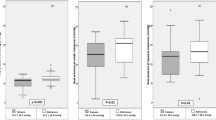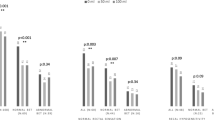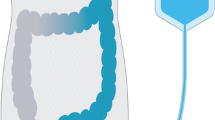Abstract
Background
A defunctioning stoma can become necessary in a relevant number of patients undergoing gastrointestinal surgery. As a matter of course, patients seek an early closure of the stoma. However, preoperative management of these patients varies and the prediction of continence after stoma removal can become challenging. Patients might be fully continent despite low manometric pressures and vice versa. An easy and reliable way to predict continence after stoma reversal would improve patients’ management and outcome. Although frequently performed in various surgical centers in Germany, there is no published data on the water-holding test. Hence, this is the first study evaluating the role of the test in clinical practice.
Method
We performed a prospective pilot study to evaluate the role of anorectal manometry and the water-holding procedure as a predictor of postoperative continence prior to stoma reversal. Inclusion criteria were a successfully passed water-holding test, any type of fecal diversion and the possibility of restoring intestinal continuity. Preoperative low manometric pressure levels were not an exclusion criteria for stoma reversal. Fifty-two patients with ostomy were consecutively enrolled in this study between October 2013 and February 2016. Anorectal manometry was performed in all patients prior to stoma reversal. After stoma removal, patients were followed-up for 6 months. Postoperative incontinence was determined using the Wexner incontinence score.
Results
A total of 52 patients (38 males, 14 females) were included at an average age of 59 (range 33–83) years. Most frequent indications for intestinal diversion were rectal cancer surgery, IBD-related surgery, or surgery for diverticular disease. Low anterior rectal resection was performed in 17 patients (32.7%), followed by a proctocolectomy in 9 (17.3%), colectomy in 9 (17.3%), and recto-sigmoid resection in 7 patients (13.5%). Median time from stoma creation to reversal was 206 days (range 48–871 days). All patients had successfully passed the standardized water-holding test. At the same time, the majority of patients had low preoperative manometric pressure values and would normally not have been reversed at that point. The median postoperative Wexner incontinence score was at 1.5 (range 0–20), 0.5 (range 0–14), and 0 (range 0–11) at 14, 60, and 180 days after stoma reversal. Low preoperative manometric squeeze and/or resting pressure levels were not associated with a higher postoperative incontinence score at 14, 60, or 180 days after stoma reversal.
Conclusion
A standardized water-holding test can function as an easy and reliable method before stoma reversal to predict sufficient postoperative fecal continence. In case of a sufficient water-holding test despite low manometric pressure levels, the risk for postoperative anal incontinence seems to be low. Preoperative manometric pressure levels do not appear to predict postoperative continence.


Similar content being viewed by others
References
Den Dulk M, Smit M, Peeters KCMJ, Kranenbarg EM-K, Rutten HJT, Wiggers T Putter H, van de Velde CJ; Dutch Colorectal Cancer Group. A multivariate analysis of limiting factors for stoma reversal in patients with rectal cancer entered into the total mesorectal excision (TME) trial: a retrospective study. Lancet Oncol 2007; 8: 297–303.
Gessler B, Haglind E, Angenete E. Loop ileostomies in colorectal cancer patients - morbidity and risk factors for nonreversal. J Surg Res 2012; 178: 708–714.
Bakx R, Busch ORC, Bemelman WA, Veldink GJ, Slors JFM, van Lanschot JJB. Morbidity of temporary loop ileostomies. Dig Surg 2004; 21: 277–281.
Schiergens TS, Hoffmann V, Schobel TN, Englert GH, Kreis ME, Thasler WE, Werner J, Kasparek MS. Long-term Quality of Life of Patients With Permanent End Ileostomy: Results of a Nationwide Cross-Sectional Survey. Dis Colon Rectum 2017; 60: 51–60.
Tsunoda A, Tsunoda Y, Narita K, Watanabe M, Nakao K, Kusano M (2008) Quality of life after low anterior resection and temporary loop ileostomy. Dis Colon Rectum 51: 218–222.
O’Leary DP, Fide CJ, Foy C, Lucarotti ME. Quality of life after low anterior resection with total mesorectal excision and temporary loop ileostomy for rectal carcinoma. Br J Surg 2001; 88: 1216–1220.
Pehl C, Enck P, Franke A, Frieling T, Heitland W, Herold A, Hinninghofen H, Karaus M, Keller J, Krammer HJ, Kreis M, Kuhlbusch-Zicklam R, Mönnikes H, Münnich U, Schiedeck T, Schmidtmann M; German Society for Neurogastroenterology and Motility; Commission Proctology of the German Society for Digestive and Metabolic Diseases; German Society for Coloproctology; Surgical Working Group Coloproctology of the German Society for Visceral Surgery on Anorectal Manometry in Adults. [Anorectal manometry]. Z Gastroenterol 2007; 45: 397–417.
Jorge JM, Wexner SD: Etiology and management of fecal incontinence. Dis Colon Rectum 1993; 36: 77–97.
Sier MF, van Gelder L, Ubbink DT, Bemelman WA, Oostenbroek RJ. Factors affecting timing of closure and non-reversal of temporary ileostomies. Int J Colorectal Dis. 2015; 30: 1185–92.
Witte M, Schwandner F, Klar E. Before and after Anorectal Surgery: Which Information Is Needed from the Functional Laboratory? Visc Med 2018; 34: 128–133.
Carrington EV, Scott SM, Bharucha A, Mion F, Remes-Troche JM, Malcolm A, Heinrich H, Fox M, Rao SS; International Anorectal Physiology Working Group and the International Working Group for Disorders of Gastrointestinal Motility and Function. Expert consensus document: Advances in the evaluation of anorectal function. Nat Rev Gastroenterol Hepatol 2018; 15: 309–323.
Rao SS. Pathophysiology of adult fecal incontinence. Gastroenterology 2004; 126: S14–22.
Diamant NE, Kamm MA, Wald A, Whitehead WE. AGA technical review on anorectal testing techniques. Gastroenterology 1999; 116: 735–760.
Alavi K, Chan S, Wise P, Kaiser AM, Sudan R, Bordeianou L. Fecal Incontinence: Etiology, Diagnosis, and Management. J Gastrointest Surg 2015; 19: 1910–21.
Rao S S, Hatfield R, Soffer E, Rao S, Beaty J, Conklin J L. Manometric tests of anorectal function in healthy adults. Am J Gastroenterol. 1999; 94: 773–783.
Read NW, Harford WV, Schmulen AC, Read MG, Santa Ana C, Fordtran JS. A clinical study of patients with fecal incontinence and diarrhea. Gastroenterology 1979; 76: 747–756.
Matheson DM, Keighley MR. Manometric evaluation of rectal prolapse and faecal incontinence. Gut 1981; 22: 126–129.
Lee SJ, Park YS: Serial evaluation of anorectal function following low anterior resection of the rectum. Int J Colorectal Dis 1998; 13: 241–246.
Van Duijvendijk P: Prospective evaluation of anorectal function after total mesorectal excision for rectal carcinoma with or without preoperative radiotherapy. Am J Gastroenterol 2002; 97: 2282–2289.
Roberts PL, Coller JA, Schoetz DJ, Veidenheimer MC. Manometric assessment of patients with obstetric injuries and fecal incontinence. Dis Colon Rectum 1990; 33: 16–20.
Parés D, Duncan J, Dudding T, Phillips RK, Norton C. Investigation to predict faecal continence in patients undergoing reversal of a defunctioning stoma (Porridge enema test). Colorectal Dis. 2008; 10: 379–85.
Brand M, Oettle GJ. The dynamic continence challenge - a simple test to predict faecal continence prior to colostomy closure. S Afr J Surg 2012; 50: 125–6.
Rao SS; American College of Gastroenterology Practice Parameters Committee. Diagnosis and management of fecal incontinence. Am J Gastroenterol. 2004; 99: 1585–604.
Author information
Authors and Affiliations
Contributions
F.S. and F.K.: Designed research, conducted clinical study, acquired data, analyzed data, wrote the manuscript. U.K.: Acquired data and analyzed data. M.G., L.S., M.W., E.K.: Acquired data and revised the manuscript critically for important intellectual content. T.S. and M.R. revised the manuscript critically for important intellectual content. All authors revised and approved the manuscript for publication.
Corresponding author
Ethics declarations
Conflict of Interest
The authors declared that they have no conflicts of interest.
Additional information
Publisher’s Note
Springer Nature remains neutral with regard to jurisdictional claims in published maps and institutional affiliations.
Rights and permissions
About this article
Cite this article
Schwandner, F., Klimars, U., Gock, M. et al. The Water-Holding Procedure for Ensuring Postoperative Continence Prior Restoring Intestinal Continuity. J Gastrointest Surg 24, 411–417 (2020). https://doi.org/10.1007/s11605-019-04171-7
Received:
Accepted:
Published:
Issue Date:
DOI: https://doi.org/10.1007/s11605-019-04171-7




